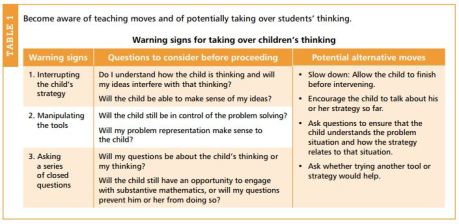Encouraging students with disabilities to think deeply about mathematics has always been one of the goals of this blog. But since the audience of this blog is mainly teachers, the goal is really to encourage teachers to encourage students with disabilities to think deeply about mathematics.
So here goes…Ask More Questions!
Duh! You’re thinking, “I asked 35 questions today! Numbers 1-35 on the multiplication fact fluency worksheet were math questions. This guy!”
But, the questions I’m referring to come after you ask those initial questions. Sure, you proposed a math problem to your students or even better they proposed one to you based on some mathematical situation you presented, but then what happened?
Andrew Stadel recently wrote about and collected questioning strategies from the MathTwitterBlogosphere. His focus was on strategies for asking questions before and after the launch of the day’s mathematical problem, task, lesson, activity, etc. My focus has been on post-launch questioning strategies. The stuck/unstuck questions and questions to explore student misconceptions. In an NCTM article, which discusses warning signs of instructional moves that generally lead to taking over student thinking, the alternative teacher moves are also focused on asking questions when a student is stuck or has a misconception.
In special education math classes, where one might find various fact fluency worksheets under the guise of differentiated instruction, it is in fact direct instruction that often rules the day when students are stuck or have misconceptions. This is because direct instruction works, sort of. But as Stanford University professor Jack Schneider states, “Still, even with informal direct instruction, the approach is teacher-centered, simplifies classroom aims to the basics, and emphasizes repetition and drill.” Is this what we want for our students with disabilities? Do we want to encourage students with disabilities to resemble robots (read: calculators) or do we want to afford students with disabilities the opportunity to use math to think critically about the world around them?
If your answer to this question is the former, I’ll save you some time and send you on your way. If your answer to this question is the latter, then read on.
Inspired by the many resources shared by the MTBoS through Andrew Stadel, I decided to try an instructional experiment in my room. Once the day’s task was launched all the teachers in the room were only allowed to ask questions as they worked with students through the problem solving process.
We are in the process of concluding our financial literacy unit and our students are now trying to create realistic monthly budgets that incorporate things like salary, rent, bills, desired item expenses and so on. In order to create our monthly budgets we needed to find out what we would earn per month. However, all we could seem to find was the minimum wage, which is only by the hour. What were we to do? (Spoiler alert: the answer is math!)
Once I (as the head teacher) had launched the task and made sure students were clear on the expectations, we broke into student pairings. I work with an assistant teacher, this class is fortunate enough to have 3 paraprofessionals, and an occupational therapist happened to be pushing into my class that period. So we had 5 staff members, enough for each to work with a pair of students. This also allowed me to float around to all the groups and not only assess the student work and thinking, but to see how my experiment was fairing for the staff members working with the students.
As I wandered around the room I could tell that students were doing all of the mathematical thinking to solve this problem and teachers were forced to curb any inclinations to directly instruct. When a student is struggling with a math problem informal direct instruction tends to at least be a fallback, if not the first, option in special education. The main result of this experiment was it increased students thinking time, because it insisted that teachers give wait time. If a teacher wanted to intervene, they had to at the very least take the time to phrase it as a question, which gave the student extra think time at each perplexing turn of the problem solving process. Table 1 (above) from the NCTM article, “Warning Signs!” implores that teachers slow down and allow children to finish before intervening. This was one of the major positive gains resulting from this experiment.
One limitation of this experiment is that it requires a lot of staffing. Our school is mandated 12:1:1, so we will never have more than 12 students in a class and our school works to make sure lack of staffing is not what holds our students back from reaching their full level of independence. But in other schools where there are staffing concerns, this experiment may not yield the same results. However, even as one teacher in a room of 30 students it would still be beneficial to your student’s thinking to pause before instructing directly or intervening and ask another question instead.
On a side-note, after reflecting on the experiment, my assistant teacher said, “It wasn’t that hard. This is what we do in class everyday anyway!”
Damn straight it is!


I love this post so much. Andrew, this is a simple effective way of dealing with a problem I see all the time. Too many special education classrooms filled with too many adults telling too too much. Questions only! I will use this from now on.
LikeLike
Thanks Rachel!
In a setting where there are many staff members working in very small groups, it is often hard to communicate effective pedagogical strategies to each staff member. This simple tip helps every staff member proceed with an effective, student-centered approach.
LikeLike